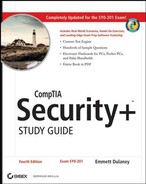7.9. Exam Essentials
Be able to describe the process of a hashing algorithm.
Hashing algorithms are used to mathematically derive a key from a message. The most common hashing standards for cryptographic applications are the SHA and MD algorithms.
Know the principles of a symmetric algorithm.
A symmetric algorithm requires that receivers of the message use the same private key. Symmetric algorithms can be extremely secure. This method is widely implemented in governmental applications. The private key is changed using out-of-band transmission.
Be able to describe the process of asymmetric algorithms.
Asymmetric algorithms use a two-key method of encryption. The message is encrypted using the public key and decrypted using a second key or private key. The key is derived from the same algorithm.
Know the primary objectives for using cryptographic systems.
The main objectives for these systems are confidentiality, integrity, authentication, and nonrepudiation. Digital signatures can be used to verify the integrity and provide nonrepudiation of a message.
Understand the process used in PKI.
PKI is an encryption system that utilizes a variety of technologies to provide confidentiality, integrity, authentication, and nonrepudiation. PKI uses certificates issued from a CA to provide this capability as well as encryption. PKI is being widely implemented in organizations worldwide.
Be able to describe the revocation process in PKI.
PKI issues a CRL from a CA when a revocation request is made. The CRL can take anywhere from a few hours to several days to propagate through a community.
Know the trust models used in PKI.
PKI provides the ability to use hierarchical, bridged, meshed, and hybrid models for trust. A CA hierarchy, or tree, is broken into subcomponents. The subcomponents are called root authorities, intermediate CAs, and leaf CAs.
Know the primary attack methods used against cryptographic systems.
The primary attacks against cryptographic systems are birthday attacks, mathematical attacks, and weak key attacks.
Identify the common technologies and methods used in encryption.
Although this chapter introduced many different protocols and standards, you need to be familiar with PKIX/PKCS, X.509, SSL/TLS, S/MIME, SSH, PGP, HTTPS, IPS, WTLS, WEP, and IPSec. Each of these standards provides specific capabilities.
Identify the stages in a key/certificate life cycle.
A life cycle involves the generation, distribution, protection, archiving, recovery, and revocation of a key or certificate. Each of these aspects of key management must be considered to provide an effective and maintainable security process.
Identify the relative advantages and disadvantages of centralized versus decentralized key management.
Centralized key management uses centralized computers to generate keys. Key generation is a very computer-intensive process. When centralized processes are used, the processes are open to single-point failure and key transmission problems. Decentralized key generation allows work to be spread over an entire organization. The disadvantage is that spreading out the process makes securing the keys more difficult. Most systems use a split method. Private keys should be transmitted using an out-of-band method.
Be able to describe the storage methods used for keys.
Physical protection methods include physical storage devices that place a key under lock and key. Storage devices include, but aren't limited to, filing cabinets and safes. Software storage refers to hardened servers or other computer systems that are used to store keys. Most keys are compromised as a result of human error.
Know the purpose of key escrow.
Key escrow allows law enforcement or other authorized governmental officials to access keys to conduct investigations. A key escrow agency or agent is a third party that is trusted to provide this service. A key archival system would normally be able to accomplish this task.
Be able to describe the purpose of key expiration.
Keys are usually stamped with an expiration date. The longer a key stays in use, the more likely it is to be compromised. The more a key is used, the more often it will need to be changed.
Understand the difference between a key revocation and a suspension.
A key revocation is performed when a key has potentially become compromised or lost. Key revocation is usually accomplished using some form of key revocation list. A certificate is revoked using a CRL process. A key is suspended when it needs to be made temporarily inactive. A suspension can be undone; a revocation can't.
Be able to describe the purpose of key recovery
Key recovery allows information to be accessed that is encrypted with older keys. For example, key recovery could be used to retrieve information from an ex-employee.
Be able to describe the M of N Control method.
The M of N Control method basically states that of n number of people, m number must be present to perform the process of key recovery. For example, if six people are authorized to use a system, three of the six must be present to recover a key. In this example, m= 3 and n = 6. This control method prevents any one person from compromising the key archival system.
Explain the purpose of key renewal.
Key renewal isn't a recommended practice. However, sometimes it may be necessary to renew a key in order to continue to use a system for a short time. The longer keys or certificates are used, the more vulnerable they are to decryption.
Know the purpose of key destruction.
Key destruction is an important part of physical control. When a physical key is retired, it should be physically destroyed. When a software key is retired, it should be erased and zeroed out to prevent inadvertent disclosure.
